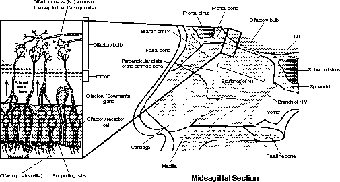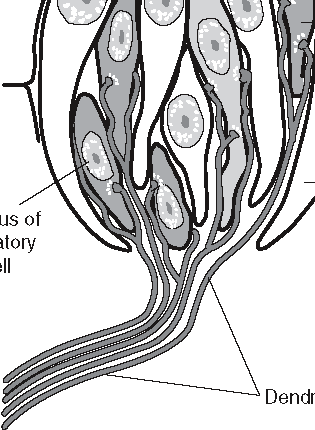Anatomy and Physiology: The Nose Knows
The Nose Knows
The sense of smell is perhaps one of the most ancient of senses. The ability to detect the presence of molecules in one's environment (for that is what smell actually is) is extremely important if you are on the search for food. This sense is highly evolved in sharks, which can sense the presence of blood (and therefore food) in the water with a concentration of one teaspoon in an Olympic-sized swimming pool! Prior to evolving as a passageway for air in higher animals, the nares, or nostrils, of a shark were (and are today) used only for smell (sharks and fish breathe through their mouths). This sense is so ancient that the olfactory nerve (N I) is not really a nerve at all, but an extension of an ancient olfactory lobe in fish.
A quick look at the nose reveals that the olfactory bulbs (the end of the nerves) are way up in the ceiling of the nasal cavity. This shows that the nose, with its turbinates (see The Respitory System), has long since evolved to place the warming, humidifying, and filtering of air as its top function, which is amply helped by the extra surface area of the turbinates. The sense of smell is, nonetheless, present and important.
Olfactory Bulbs
Smell is an interesting sense, for unlike vision or sound, in which interpretation is so important, smell is more straightforward. For smell to respond to molecules, the molecule needs to temporarily bind to receptors in the roof of the nasal cavity. Unlike other receptors for senses such as vision, hearing, balance, and taste, the olfactory receptors are actually bipolar neurons, and the chemicals that bond with the cilia, known as olfactory hairs, on that neuron will stimulate an action potential directly.
The olfactory nerve (N I) ends with olfactory bulbs at the base of the ethmoid bone (see Figure 21.5); axons pass through the cribriform plate of that bone, thus giving it a somewhat porous appearance. Beneath this plate is a connective tissue layer, with the olfactory epithelium beneath it, with supporting cells interspersed with the dendrites of the bipolar neurons. Olfactory or Bowman's glands in the connective tissue produce mucus that is crucial to the sense of smell.
The mucus provides a fluid that dissolves the gaseous odors. The molecules thus make contact with the olfactory hairs within this thin film of mucus. If the mucus were not continually replaced, any dissolved odor would continue to make contact with the olfactory hairs, and continue to stimulate the neuron. Talk about a smell that wouldn't go away! By replacing the mucus, the olfactory hairs are available for any new molecules that come their way!
Get a Whiff of Turbulence
The turbinates are a collection of bones (the left and right inferior nasal concha) and bone landmarks (the superior and middle nasal concha, left and right, which are extensions on the ethmoid bone) that increase the turbulence of the air inhaled. By inhaling more deeply, the molecules are forced higher up in the nasal cavity, up to the olfactory nerves. This explains why people sniff in order to better smell their world.
In Good Taste

Figure 21.5The olfactory bulbs, at the end of the olfactory nerve (N I), are found in the roof of the nasal cavity. (LifeART©1989-2001, Lippincott Williams & Wilkins)
Taste is an integral part of our lives, often to our detriment, as we tend to go toward tastes we prefer, rather than those that are beneficial to our health. There is a certain amount of irony here, for we evolved our taste buds to emphasize those molecules that helped us to survive. The irony melts away, however, when you examine the details. One of the greatest of our needs is energy. As such, certain molecules were so important for our evolutionary ancestors to acquire that they evolved a preference for them. (If the molecules didn't taste good, why would an animal eat them?) These high-energy molecules include simple and complex carbohydrates and fats, and it's the proportions of these compounds in our diet that is the problem. As with smell, these gustatory receptors are based on the presence of molecules binding directly with the receptors. The tongue itself is made of numerous papillae, and the tongue's 10,000 or so taste buds are found not on the upper surface of each papilla, but along the sides. The bulk of each taste bud is found in the wall of the papillae, with gustatory hairs, basically one microvillus on each gustatory receptor cell, sticking out through a hole called a taste pore. Each taste bud contains about 50 of these receptor cells (each of which only lasts about 10 days and so they are constantly replaced), interspersed with supporting cells, all of which are epithelial, unlike those in the nasal cavity.
Similar to smell, the molecules we taste are dissolved in a fluid, in this case saliva. Contact with the receptor cells opens ion channels that stimulate the neurons responsible for taste (see Figure 21.6). All food is a combination of four primary tastes: sour (acidic), bitter (basic), salty, and sweet. These four tastes can be perceived at any taste bud, although the taste buds in certain parts of the tongue appear to be more sensitive to specific tastes, and are thus called taste zones: sweet and salty in the front, bitter in the back, and sour on the sides. It may seem ironic that the body (the center) of the tongue has very few taste buds, but then again, the teeth we chew our food with are on the edges, so it makes sense that those edges would be rich in taste buds!

Figure 21.6Gustatory receptors, or taste buds, stimulate neurons in the presence of food molecules. (LifeART©1989-2001, Lippincott Williams & Wilkins)

Excerpted from The Complete Idiot's Guide to Anatomy and Physiology © 2004 by Michael J. Vieira Lazaroff. All rights reserved including the right of reproduction in whole or in part in any form. Used by arrangement with Alpha Books, a member of Penguin Group (USA) Inc.
To order this book direct from the publisher, visit the Penguin USA website or call 1-800-253-6476. You can also purchase this book at Amazon.com and Barnes & Noble.







